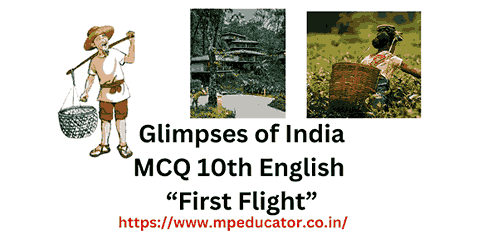MCQs Glimpses of India
MCQs Glimpses of India from Chapter 5 “Glimpses of India,” from the English textbook First Flight for Class 10, introduces students to India’s rich cultural and natural diversity through three distinct parts: A Baker from Goa, Coorg, and Tea from Assam.

Part I: A Baker from Goa
In this section, the author describes the unique tradition of baking in Goa, a practice that dates back to Portuguese rule. Bakers, also known as “pader,” were an integral part of Goan life. The chapter nostalgically recalls the daily arrival of bakers, their bamboo sticks announcing their presence, and the anticipation for fresh, crusty bread loaves. Even after the Portuguese left, the tradition of baking has remained a cultural staple. This part sheds light on how certain colonial influences continue to persist in local Indian customs.
Part II: Coorg
Coorg, also known as Kodagu, is a picturesque hill station in Karnataka, often referred to as “the land of rolling hills.” This part of the chapter takes readers through the natural beauty, lush greenery, and diverse flora and fauna of Coorg. Known for its coffee plantations, rich culture, and the valor of its Kodava community, Coorg is described as a place filled with adventure, from trekking and river rafting to discovering a blend of traditional and modern lifestyles. The chapter also highlights the Kodava people’s distinct culture, warrior-like traditions, and close connections with the Indian army.
Part III: Tea from Assam
The final part takes readers to Assam, a northeastern state famous for its sprawling tea gardens and high-quality tea. The author brings in interesting facts about how tea was introduced to India and emphasizes India’s place as one of the largest tea producers in the world. Through the story of a young boy Rajvir visiting Assam, the chapter details the lush green tea estates, the unique process of tea making, and the various myths surrounding tea’s origins, creating a vivid picture of Assam’s contribution to this global beverage.
Together, these parts offer a glimpse into the cultural, historical, and geographical diversity of India, celebrating its rich heritage through relatable and engaging narratives.
- Lucio Rodrigues in A Baker from Goa offers a nostalgic glimpse into Goan life, depicting how the Portuguese-era tradition of baking still thrives in the state. The story brings out the social and cultural importance of bakers, known as “pader,” who continue to play a role in daily Goan life.
- Lokesh Abrol in Coorg presents a vivid description of Coorg, a region known for its breathtaking scenery, coffee plantations, and the unique culture of the Kodava people. His writing emphasizes the adventurous spirit and traditional values of the Kodava community while showcasing the area’s natural beauty and attractions, from trekking and river rafting to discovering the region’s rich biodiversity.
- Arup Kumar Datta in Tea from Assam takes readers through Assam’s lush tea estates, celebrating India’s role as one of the largest tea producers in the world. The story of Rajvir’s visit to Assam offers insights into tea’s history, myths, and the intricate processes involved in tea production.
Together, these authors paint a vibrant picture of India’s diversity, blending history, culture, and tradition in a way that connects with readers, helping them appreciate the many facets of Indian life and heritage.
Chapter 5 – Glimpses of India के तीनों भाग के लेखक निम्नलिखित हैं: भाग I: A Baker from Goa – इस भाग के लेखक हैं लुसियो रोड्रिग्स (Lucio Rodrigues)। उन्होंने गोवा की बेकरी परंपरा और वहाँ के बेकर्स के जीवन का सुंदर वर्णन किया है। भाग II: Coorg – इस भाग के लेखक हैं लोकनाथ याज्ञिक (Lokesh Abrol)। उन्होंने कर्नाटक के कुर्ग क्षेत्र की प्राकृतिक सुंदरता, संस्कृति, और वहाँ के निवासियों के साहसिक जीवन का वर्णन किया है। भाग III: Tea from Assam – इस भाग के लेखक हैं अरुप कुमार दत्ता (Arup Kumar Datta)। इस लेख में उन्होंने असम के चाय बागानों, वहाँ की चाय की विविधता और इसके उत्पादन प्रक्रिया के बारे में बताया है।